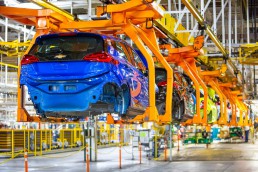AT&T (T)
Innovation is an American tradition, and few modern companies are as directly tied to that spirit as AT&T (T), the multinational holding company that can trace its roots back to the Bell Telephone Company, founded by telephone inventor Alexander Graham Bell in 1877. Today it is the world’s largest telecommunications company, the largest mobile services provider and the largest network operator in the U.S.
AT&T currently operates DirecTV, AT&T Mexico and a long list of other subsidiaries including Ameritech, BellSouth, Pacific Telesis and SBC Communications. It is also the parent company of mass media conglomerate WarnerMedia.
AT&T reported $170 billion in revenue in 2018. For the second quarter of 2019, it generated $35 billion from its communications business, accounting for roughly 80% of revenue. The company employs more than 250,000 and operates worldwide, including voice service in 225 countries and data service in 210 countries.
Rationale
The most direct way to gain exposure to AT&T is to buy its listed shares. But investors have good reason to reconsider that approach given AT&T’s long-term growth prospects and its current price. Much of T’s revenue is driven by landline service, which is dying out around the world. Although it is expanding into mobile communications service and other offerings, it is still tied to a fading technology.
However, for investors interested in gaining exposure to the communications sector, rather than buying T shares themselves should consider buying funds that provide exposure to AT&T and other similar firms. After all, the return drivers that will benefit T might also benefit other similar firms in communications that are better diversified. As investment management is gradually moving to the construction of portfolios using ETFs and mutual funds in addition to single stocks, investors would do well to consider gain exposure to firms like T through these types of funds.
Investing in T
A search on Magnifi suggests that investors can gain access to AT&T via a number of different funds and ETFs, including those shown below.
Schedule a demo and unlock
a 14-day free trial of Magnifi Pro+
Magnifi is changing the way we shop for investments, with the world’s first semantic search engine for finance that helps users discover, compare and buy investment products such as ETFs, mutual funds and stocks. Try it for yourself today.
This blog is sponsored by Magnifi. The information and data are as of the publish date unless otherwise noted and subject to change. This material is provided for informational purposes only and should not be construed as individualized investment advice or an offer or solicitation to buy or sell securities tailored to your needs. This information covers investment and market activity, industry or sector trends, or other broad-based economic or market conditions and should not be construed as investment research or advice. Investors are urged to consult with their financial advisors before buying or selling any securities. Although certain information has been obtained from sources believed to be reliable, we do not guarantee its accuracy, completeness or fairness. Past performance is no guarantee of future results. This content may not be reproduced or distributed to any person in whole or in part without the prior written consent of Magnifi. [As a technology company, Magnifi provides access to tools and will be compensated for providing such access. Magnifi does not provide broker-dealer, custodian, investment advice or related investment services.]
Alphabet (GOOG)
You know you’re one of the largest, most successful companies in the world when you can change your name and still not miss a beat in terms of investor interest. But that’s exactly what the conglomerate Alphabet (GOOG) did in 2015 when it was created as part of Google’s corporate restructure. Today, Alphabet is the parent company of Google as well as a number of its subsidiaries. The idea was to create a structure with “greater autonomy” and allow Google to expand into other businesses beyond simply internet services.
In addition to Google, Alphabet’s subsidiaries include Calico, DeepMind, GV, CapitalG, X, Google Fiber, Jigsaw, Makani, Sidewalk Labs, Verily, Waymo, Wing and Loon. It also oversees former Google projects such as YouTube, the Android mobile operating system and more.
Alphabet reported more than $110 billion in total revenue in 2017, 86% of which comes from advertising via Adsense and Google’s AdWords products, 53% of which operates outside of the U.S.
Rationale
The most direct way to gain exposure to Alphabet is to buy its listed shares. But investors have good reason to reconsider that approach given GOOG’s long-term growth prospects and its current price. What was once a high-growth internet startup is now a well-established digital enterprise, and the creation of Alphabet as the Google holding company only solidified that fact. GOOG itself is no longer a growth holding.
However, for investors interested in gaining exposure to the internet sector, rather than buying GOOG shares themselves should consider buying funds that provide exposure to Alphabet and other and other similar firms. After all, the return drivers that will benefit GOOG might also benefit other similar firms in internet services. As investment management is gradually moving to the construction of portfolios using ETFs and mutual funds in addition to single stocks, investors would do well to consider gain exposure to firms like GOOG through these types of funds.
Investing in GOOG
A search on Magnifi suggests that investors can gain access to Alphabet via a number of different funds and ETFs, including those shown below.
Schedule a demo and unlock
a 14-day free trial of Magnifi Pro+
Magnifi is changing the way we shop for investments, with the world’s first semantic search engine for finance that helps users discover, compare and buy investment products such as ETFs, mutual funds and stocks. Try it for yourself today.
This blog is sponsored by Magnifi. The information and data are as of the publish date unless otherwise noted and subject to change. This material is provided for informational purposes only and should not be construed as individualized investment advice or an offer or solicitation to buy or sell securities tailored to your needs. This information covers investment and market activity, industry or sector trends, or other broad-based economic or market conditions and should not be construed as investment research or advice. Investors are urged to consult with their financial advisors before buying or selling any securities. Although certain information has been obtained from sources believed to be reliable, we do not guarantee its accuracy, completeness or fairness. Past performance is no guarantee of future results. This content may not be reproduced or distributed to any person in whole or in part without the prior written consent of Magnifi. [As a technology company, Magnifi provides access to tools and will be compensated for providing such access. Magnifi does not provide broker-dealer, custodian, investment advice or related investment services.]
Citicorp (C)
One of the largest financial services companies in the world, Citicorp (C) is also the parent company of one of the oldest banks in the U.S., Citibank, which can trace its roots back to the City Bank of New York, founded in 1812. Citibank today has more than 2,600 branch locations in 19 countries, although most of its operations are focused in the United States and Mexico.
Formed by the merge of Citicorp and Travelers Group in 1998, Citicorp’s business can today be split in two – investment banking and financial services, both tied to each of the original partner companies. Citicorp is the third largest bank in the U.S. and is considered a “systemically important financial institution” by U.S. regulators, placing it on the “too big to fail” list, leading to its government bailout in 2009.
As of 2019, Citi has more than 200 million customer accounts and offices in more than 160 countries. Its revenues for 2018 totaled more than $72 billion.
Rationale
As a Big 4 financial institution, naturally the simplest way to gain exposure to Citicorp is to buy its listed shares. But given Citi’s rocky history in recent years, that can open investors up to excess risk. Citicorp was the recipient of more than $300 billion in bailout funds in the wake of the 2008 financial crisis and, although operations have stabilized since then, its business is largely left to the whims of the global financial system. Given its size, there is little Citigroup can do to outperform its peers directly.
A solution that can dampen some of that volatility is to buy funds that provide exposure to Citicorp and other similar firms, rather than C shares themselves. After all, the return drivers that will benefit Citi might also benefit other similar firms in financial services. As investment management is gradually moving to the construction of portfolios using ETFs and mutual funds in addition to single stocks, investors would do well to consider gain exposure to firms like C through these types of funds.
Investing in C
A search on Magnifi suggests that investors can gain access to C via a number of different funds and ETFs, including those shown below.
Schedule a demo and unlock
a 14-day free trial of Magnifi Pro+
Magnifi is changing the way we shop for investments, with the world’s first semantic search engine for finance that helps users discover, compare and buy investment products such as ETFs, mutual funds and stocks. Try it for yourself today.
This blog is sponsored by Magnifi. The information and data are as of the publish date unless otherwise noted and subject to change. This material is provided for informational purposes only and should not be construed as individualized investment advice or an offer or solicitation to buy or sell securities tailored to your needs. This information covers investment and market activity, industry or sector trends, or other broad-based economic or market conditions and should not be construed as investment research or advice. Investors are urged to consult with their financial advisors before buying or selling any securities. Although certain information has been obtained from sources believed to be reliable, we do not guarantee its accuracy, completeness or fairness. Past performance is no guarantee of future results. This content may not be reproduced or distributed to any person in whole or in part without the prior written consent of Magnifi. [As a technology company, Magnifi provides access to tools and will be compensated for providing such access. Magnifi does not provide broker-dealer, custodian, investment advice or related investment services.]
Lululemon (LULU)
Who knew that selling yoga pants could be so lucrative? Chip Wilson, the founder of Canadian athleticwear retailer Lululemon Athleta (LULU) certainly did when he started the company out of his Vancouver apartment in 1998. In part, LULU arrived at just the right time. In the early 2000s, yoga was on an upswing, and between 2012 and 2016 the number of Americans doing yoga grew by 50%. Today, 1/3 of all Americans has tried it at least one, and the population of over-50 practitioners has tripled since 2015.
Lululemon designs and sells a wide variety of athletic wear, having expanded beyond its core product of yoga pants. Today the inventory in its 460 stores includes tops, casual pants, shorts, sweaters, jackets, undergarments, accessories, yoga mats, water bottles, shoes and more.
In 2018, Lululemon reported revenue of $3.29 billion, up from just $358 million a decade earlier.
Rationale
A direct way to gain exposure to Lululemon is to buy the listed shares. But that can be a risky approach, given LULU’s focus on the consumer market. It’s fair to believe that Chip Wilson caught lightning in a bottle with the explosive growth of the yoga market shortly after he launched the company, but Lululemon’s breakneck growth since then has largely been predicated on new store openings and reaching out to new potential customers. However, fashion trends can change rapidly, and the population of customers who have not yet tried yoga or purchased from Lululemon is shrinking, reducing its future growth potential.
A solution that can dampen some of that volatility is to buy funds that provide exposure to Lululemon and other similar firms, rather than LULU shares themselves. After all, the return drivers that will benefit Lululemon might also benefit other similar firms in sporting goods, athleticwear, and footwear. As investment management is gradually moving to the construction of portfolios using ETFs and mutual funds in addition to single stocks, investors would do well to consider gain exposure to firms like LULU through these types of funds.
Investing in LULU
A search on Magnifi suggests that investors can gain access to LULU via a number of different funds and ETFs, including those shown below.
Schedule a demo and unlock
a 14-day free trial of Magnifi Pro+
Magnifi is changing the way we shop for investments, with the world’s first semantic search engine for finance that helps users discover, compare and buy investment products such as ETFs, mutual funds and stocks. Try it for yourself today.
This blog is sponsored by Magnifi. The information and data are as of the publish date unless otherwise noted and subject to change. This material is provided for informational purposes only and should not be construed as individualized investment advice or an offer or solicitation to buy or sell securities tailored to your needs. This information covers investment and market activity, industry or sector trends, or other broad-based economic or market conditions and should not be construed as investment research or advice. Investors are urged to consult with their financial advisors before buying or selling any securities. Although certain information has been obtained from sources believed to be reliable, we do not guarantee its accuracy, completeness or fairness. Past performance is no guarantee of future results. This content may not be reproduced or distributed to any person in whole or in part without the prior written consent of Magnifi. [As a technology company, Magnifi provides access to tools and will be compensated for providing such access. Magnifi does not provide broker-dealer, custodian, investment advice or related investment services.]
Facebook (FB)
Founded in a Harvard dorm room in 2004, Facebook (FB) has in the intervening years become one of the major companies of our time. Far from the first social network on the internet, Facebook has however established itself as the most successful, boasting more than 2.4 billion active users worldwide and 85 offices spread across 35 countries.
As of 2019, Facebook has a market cap of more than $460 billion, and the company reported total revenue of nearly $56 billion in 2018, mostly generated from online advertising. That figure was up 37% from the $40 billion in revenue the company reported in 2017. The company has been actively acquiring other companies since its founding and currently owns Instagram, WhatsApp, Occulus VR, FriendFeed and adtech company LiveRail among its total 79 businesses.
Facebook’s 2012 IPO was the largest tech IPO in U.S. history, with more than 421 million shares priced at $38 per share raising roughly $16 billion.
Rationale
A direct way to gain exposure to Facebook is to buy the listed shares. But, despite its growth, Facebook remains a volatile and uncertain company. It is still only 15 years old, so it continues to experience growing pains in its new industry. What’s more, potential government regulation of the platform could slow its growth going forward.
A solution that can dampen some of that volatility is to buy funds that provide exposure to Facebook and other similar firms, rather than FB shares themselves. After all, the return drivers that will benefit Facebook might also benefit other similar firms in online advertising, digital media, and hardware. As investment management is gradually moving to the construction of portfolios using ETFs and mutual funds in addition to single stocks, investors would do well to consider gain exposure to firms like Facebook through these types of funds.
Investing in FB
A search on Magnifi suggests that investors can gain access to Facebook via a number of different funds and ETFs, including those shown below.
Schedule a demo and unlock
a 14-day free trial of Magnifi Pro+
Magnifi is changing the way we shop for investments, with the world’s first semantic search engine for finance that helps users discover, compare and buy investment products such as ETFs, mutual funds and stocks. Try it for yourself today.
This blog is sponsored by Magnifi. The information and data are as of the publish date unless otherwise noted and subject to change. This material is provided for informational purposes only and should not be construed as individualized investment advice or an offer or solicitation to buy or sell securities tailored to your needs. This information covers investment and market activity, industry or sector trends, or other broad-based economic or market conditions and should not be construed as investment research or advice. Investors are urged to consult with their financial advisors before buying or selling any securities. Although certain information has been obtained from sources believed to be reliable, we do not guarantee its accuracy, completeness or fairness. Past performance is no guarantee of future results. This content may not be reproduced or distributed to any person in whole or in part without the prior written consent of Magnifi. [As a technology company, Magnifi provides access to tools and will be compensated for providing such access. Magnifi does not provide broker-dealer, custodian, investment advice or related investment services.]
Apple (AAPL)
Apple (AAPL) is a Silicon Valley legend. Literally founded in a garage – in this case, belonging to Steve Jobs’ parents in Los Altos – Apple got its start in 1976 when cofounders Jobs and Steve Wozniak began building the very first Apple personal computers by hand, shipping them in handmade wooden cases. Always the showman, Jobs later said that the company’s name was a nod to a “fruitarian” diet he was on at the time. He had just come back from an apple farm, and thought the name sounded “fun, spirited and not intimidating.”
That was then.
Today Apple produces far more than just Apple computers, including such products as the iPhone, Apple Watch, Apple TV, iPad, AirPods and much more, including a wide variety of Macbook laptops and Mac desktops.
Apple is among the world’s most valuable companies, with a net worth of more than $1 trillion and annual revenues of $265 billion in 2018. It is the world’s largest technology company by revenue and employs 123,000 full-time employees and maintained 504 retail stores in 24 countries as of 2018. There are currently more than 1.3 billion Apple products in use worldwide, ranking it as the world’s most valuable brand.
Rationale
A direct way to gain exposure to Apple is to buy the listed shares. But that can be a risky approach, given Apple’s focus on the consumer market. Consumers can be finicky, and what sells today (like iPhones) may not sell as strongly tomorrow or next year. As such, Apple is forced to constantly innovate in hopes of finding the next big tech trend. The company has done this successfully for more than 40 years, but the innovation cycle is accelerating.
A solution that can dampen some of that volatility is to buy funds that provide exposure to Apple and other similar firms, rather than AAPL shares themselves. After all, the return drivers that will benefit Apple might also benefit other similar firms in consumer electronics, computer hardware and personal entertainment. As investment management is gradually moving to the construction of portfolios using ETFs and mutual funds in addition to single stocks, investors would do well to consider gain exposure to firms like Apple through these types of funds.
Investing in AAPL
A search on Magnifi suggests that investors can gain access to Apple via a number of different funds and ETFs, including those shown below.
Schedule a demo and unlock
a 14-day free trial of Magnifi Pro+
Magnifi is changing the way we shop for investments, with the world’s first semantic search engine for finance that helps users discover, compare and buy investment products such as ETFs, mutual funds and stocks. Try it for yourself today.
This blog is sponsored by Magnifi. The information and data are as of the publish date unless otherwise noted and subject to change. This material is provided for informational purposes only and should not be construed as individualized investment advice or an offer or solicitation to buy or sell securities tailored to your needs. This information covers investment and market activity, industry or sector trends, or other broad-based economic or market conditions and should not be construed as investment research or advice. Investors are urged to consult with their financial advisors before buying or selling any securities. Although certain information has been obtained from sources believed to be reliable, we do not guarantee its accuracy, completeness or fairness. Past performance is no guarantee of future results. This content may not be reproduced or distributed to any person in whole or in part without the prior written consent of Magnifi. [As a technology company, Magnifi provides access to tools and will be compensated for providing such access. Magnifi does not provide broker-dealer, custodian, investment advice or related investment services.]
Caterpillar (CAT)
The economic bellwether that no one ever thinks about, Caterpillar (CAT) is a company that designs, develops, engineers, manufactures, markets and sells heavy machinery and engines, including construction equipment, financial products and insurance worldwide. It is the world’s largest construction equipment manufacturer. As such, its success and failure are seen as a preview of what’s to come next for the economy at large.
The company was founded by the 1925 merger of the Holt Manufacturing Company and the C. L. Best Tractor Company, both of which were leaders in the field of steam equipment. Following the merger, CAT consolidated its product lines, eventually expanding into military vehicles and hardware sold to the U.S. Department of Defense in World War II.
Today, Caterpillar produces machines ranging from tractors to hydraulic excavators, backhoe loaders, motor graders, off-highway trucks, wheel loaders, agricultural tractors, locomotives and more. Its products are used in the construction, road-building, mining, forestry, energy, transportation and material-handling industries.
Rationale
A direct way to gain exposure to Caterpillar is to buy the listed shares. But that can be a risky approach, given Caterpillar’s wide business interests. It’s no accident that fluctuations in CAT’s stock price are seen as an economic bellwether – a slowdown in construction spending often portends a broader economic slowdown. That ties Caterpillar closely to market forces that are outside of its control.
A solution that can dampen some of that volatility is to buy funds that provide exposure to Caterpillar and other similar firms, rather than CAT shares themselves. After all, the return drivers that will benefit Caterpillar might also benefit other similar firms in construction, manufacturing, and heavy industry. As investment management is gradually moving to the construction of portfolios using ETFs and mutual funds in addition to single stocks, investors would do well to consider gain exposure to firms like CAT through these types of funds.
Investing in CAT
A search on Magnifi suggests that investors can gain access to CAT via a number of different funds and ETFs, including those shown below.
Schedule a demo and unlock
a 14-day free trial of Magnifi Pro+
Magnifi is changing the way we shop for investments, with the world’s first semantic search engine for finance that helps users discover, compare and buy investment products such as ETFs, mutual funds and stocks. Try it for yourself today.
This blog is sponsored by Magnifi. The information and data are as of the publish date unless otherwise noted and subject to change. This material is provided for informational purposes only and should not be construed as individualized investment advice or an offer or solicitation to buy or sell securities tailored to your needs. This information covers investment and market activity, industry or sector trends, or other broad-based economic or market conditions and should not be construed as investment research or advice. Investors are urged to consult with their financial advisors before buying or selling any securities. Although certain information has been obtained from sources believed to be reliable, we do not guarantee its accuracy, completeness or fairness. Past performance is no guarantee of future results. This content may not be reproduced or distributed to any person in whole or in part without the prior written consent of Magnifi. [As a technology company, Magnifi provides access to tools and will be compensated for providing such access. Magnifi does not provide broker-dealer, custodian, investment advice or related investment services.]
General Motors (GM)
Once the largest automotive manufacturer in the world, General Motors (GM) today remains the largest U.S. carmaker, producing more than 8.3 million cars and trucks annually. The company traces its roots back to the Durant-Dort Carriage Company, which was the country’s leading manufacturer of horse-drawn vehicles by 1904, when it merged with the Buick Motor Company to take on the then-new market for gas-powered vehicles. By 1962, more than half of all cars sold in the U.S. were produced by General Motors.
Today the company, headquartered in Detroit, designs, manufactures, markets, and distributes vehicles and vehicle parts, in addition to financial services. It has facilities in 37 countries and owns brands including Chevrolet, Buick, GMC and Cadillac, as well as overseas brands such as Holden, Wuling, Baojun and Jiefang.
GM’s worldwide sales volume reached 10 million vehicles in 2016 and the company reported $147 billion in revenue in 2018.
Rationale
A direct way to gain exposure to General Motors is to buy the listed shares. But that can be a risky approach, given GM’s bumpy business history and the current state of the U.S. auto industry as a whole. GM famously declared bankruptcy in 2009 following years of declining sales and was later bailed out by the government in 2014 through the Troubled Asset Relief Program.
A solution that can dampen some of that volatility is to buy funds that provide exposure to General Motors and other similar firms, rather than GM shares themselves. After all, the return drivers that will benefit GM might also benefit other similar firms in automotive, manufacturing, and financial services. As investment management is gradually moving to the construction of portfolios using ETFs and mutual funds in addition to single stocks, investors would do well to consider gain exposure to firms like GM through these types of funds.
Investing in GM
A search on Magnifi suggests that investors can gain access to GM via a number of different funds and ETFs, including those shown below.
Schedule a demo and unlock
a 14-day free trial of Magnifi Pro+
Magnifi is changing the way we shop for investments, with the world’s first semantic search engine for finance that helps users discover, compare and buy investment products such as ETFs, mutual funds and stocks. Try it for yourself today.
This blog is sponsored by Magnifi. The information and data are as of the publish date unless otherwise noted and subject to change. This material is provided for informational purposes only and should not be construed as individualized investment advice or an offer or solicitation to buy or sell securities tailored to your needs. This information covers investment and market activity, industry or sector trends, or other broad-based economic or market conditions and should not be construed as investment research or advice. Investors are urged to consult with their financial advisors before buying or selling any securities. Although certain information has been obtained from sources believed to be reliable, we do not guarantee its accuracy, completeness or fairness. Past performance is no guarantee of future results. This content may not be reproduced or distributed to any person in whole or in part without the prior written consent of Magnifi. [As a technology company, Magnifi provides access to tools and will be compensated for providing such access. Magnifi does not provide broker-dealer, custodian, investment advice or related investment services.
Tesla (TSLA)
Few companies capture the spirit of innovation as it exists today as Tesla (TSLA), the California-based maker of electric cars, advanced battery systems, solar panels and other world-changing inventions. Founded in 2003 by engineers Martin Eberhard and Marc Tarpenning, Tesla was soon thereafter joined by current CEO Elon Musk, who invested in the company’s Series A round.
And the rest is history.
As of 2019, Tesla is producing three models of its all-electric vehicles — the Model S liftback sedan, the Model X SUV, and the Model 3 affordable sedan — and has new versions in development including the Model 3 crossover SUV, Roadster sports car and the Semi battery powered Class 8 semi-trailer truck. The company also produces solar panels and solar roof tiles via its SolarCity subsidiary, as well as whole-home rechargeable lithium ion battery systems the Powerwall and Powerpack and the Megapack, a Lithium-ion grid energy storage battery.
As of 2018, Telsa controlled 12% of the global market for plug-in electric passenger cars, with more than 245,000 vehicles delivered, making it the world’s best selling builder in its category.
Rationale
A direct way to gain exposure to Tesla is to buy the listed shares. However, this can be a volatile approach, given the company’s early stage and ongoing growing pains. A solution that can dampen some of that volatility is to buy funds that provide exposure to Tesla and other similar firms, rather than TSLA shares themselves. After all, the return drivers that will benefit Tesla might also benefit other similar firms in their industry, including those making electric vehicles as well as components and infrastructure for the industry.
As investment management is gradually moving to the construction of portfolios using ETFs and mutual funds in addition to single stocks, investors would do well to consider gain exposure to firms like Tesla through these types of funds.
Investing in TSLA
A search on Magnifi suggests that investors can gain access to Tesla via a number of different funds and ETFs, including those shown below.
Schedule a demo and unlock
a 14-day free trial of Magnifi Pro+
Magnifi is changing the way we shop for investments, with the world’s first semantic search engine for finance that helps users discover, compare and buy investment products such as ETFs, mutual funds and stocks. Try it for yourself today.
This blog is sponsored by Magnifi. The information and data are as of the publish date unless otherwise noted and subject to change. This material is provided for informational purposes only and should not be construed as individualized investment advice or an offer or solicitation to buy or sell securities tailored to your needs. This information covers investment and market activity, industry or sector trends, or other broad-based economic or market conditions and should not be construed as investment research or advice. Investors are urged to consult with their financial advisors before buying or selling any securities. Although certain information has been obtained from sources believed to be reliable, we do not guarantee its accuracy, completeness or fairness. Past performance is no guarantee of future results. This content may not be reproduced or distributed to any person in whole or in part without the prior written consent of Magnifi. [As a technology company, Magnifi provides access to tools and will be compensated for providing such access. Magnifi does not provide broker-dealer, custodian, investment advice or related investment services.
Military & Defense
How to Invest in the Future of Military Technology
It’s been said that the only guarantees in life are death and taxes, but there is another fact of life that has remained constant for much of human history: war. For millennia, people have fought with one another — over land, over titles and even over resources — and these conflicts eventually lead to the development of new weapons, military technologies and a worldwide industry dedicated to supporting these efforts.
We saw it around 400 BC, when Athens and Sparta, two of the most powerful city-states in ancient Greece, went to battle with each other in the Peloponnesian War.
We saw it again during the Roman conquest of Britain, which lasted until 400 AD.
And, of course, we saw it more recently during the American and French Revolutions in the 18th century.
In each of these instances, the outcome of these wars not only radically shifted the world’s power structure at the time, they also led to the development of new weapons and tactics. Battles that had once been fought with rocks and spears eventually moved on to bronze swords and arrows, then primitive cannons and firearms, to aircraft, today’s drones and more.
Over the last 3,000 years, the entire concept of war has evolved and today the military and defense industries are among the largest and most profitable on the planet. According to the Aerospace Industries Association (AIA), the U.S. aerospace and defense industry generated a total of $62.6 billion in federal and state tax receipts in 2015, the most recent year that data is available. That figure was up 2.9% from $60.9 billion in 2014 and $60.6 billion in 2013.
[Today’s warfare is virtual as well. Here’s what you need to know about Cybersecurity]
Overall, the defense industry posted more than $604 billion in sales in 2015, with end-use buyers (such as militaries, defense contractors and others) accounting for 58% or $349 billion of that total, followed by the industry’s supply chain (parts suppliers going to larger manufacturers) with the remaining 42% or $256 billion. Direct sales brought in an additional $181 billion in the U.S. alone.
By 2018, defense spending totaled $622 billion, accounting for about 3.1% of U.S. GDP.
And military technology is a strong job creator as well. Per the AIA report: “The U.S. Aerospace and Defense (A&D) industry is the world’s leading innovator and producer of technologically advanced aircraft, space and defense systems and supports one of the largest high-skill and high-wage workforces in the nation. Indeed, in 2015, the U.S. A&D industry supported nearly 1.7 million jobs in companies producing products and services for the industry’s commercial aerospace and defense manufacturing sectors. Of the jobs supported, 697,000 or 42 percent, were attributable to firms producing end-use goods and services, such as aircraft, space systems, land vehicles, ships and armaments, while 965,000, or 58 percent were attributable to the industry’s extensive supply chain. Combined, these jobs accounted for approximately two percent of the nation’s total employment base and 13 percent of the nation’s manufacturing workforce.”
What Is the Defense Industry?
At the highest level, Webster’s dictionary defines the term “military” as anything “relating to soldiers, arms, or war or relating to armed forces.” This can include both ground and air forces as well as naval forces as well as the work “performed or made by armed forces.” Simply put, military forces and the related defense industries are those dedicated to fighting wars and working toward national defense, regardless of country.
The industry that supplies the world’s militaries, as well as its defense contractors and private security forces, is broadly included in the defense industry, which manufactures and sells weapons and military technology. This includes everything from firearms, to military aircraft, vehicles, software, tactical clothing and more, as well as the servicing of military material, equipment and facilities and other logistical and operational support.
Defense and aerospace companies are involved in the development, production and marketing of “guns, artillery, ammunition, missiles, military aircraft, military vehicles, ships, electronic systems, night-vision devices, holographic weapon sights, laser rangefinders, laser sights, hand grenades, landmines and more.”
Notable companies in the military and defense sector include Boeing, EADS/Airbus, United Technologies, Raytheon, Northrop Grumman and General Atomics Aeronautical Systems. Symantec, McAfee, Trend Micro and EMC are among the industry’s key security software and technology providers.
Why Invest in Military and Defense?
To put it mildly, defense is one of the world’s largest, most stable industries. As long as there is conflict, as long as there is war, there will be demand for new weapons systems and technology.
That’s one reason why Deloitte, in its 2019 Global Aerospace and Defense Industry Outlook said: “In 2018, the global aerospace and defense (A&D) industry recuperated and experienced a solid year as passenger travel demand strengthened and global military expenditure continued to rise. The industry is expected to continue its growth trajectory in 2019, led by growing commercial aircraft production and strong defense spending.”
Among the growth catalysts cited by Deloitte are intensifying geopolitical tensions all over the world, changes to international trade agreements that have the potential to disrupt the global supply chain as well as M&A activity that’s sweeping across the industry as suppliers look to cut costs while also increasing production. All of these factors are expected to drive new demand for military equipment and defense spending in markets all over the world.
And that’s to say nothing about the new technologies that are redefining the space. Deloitte cites intelligence, surveillance, target acquisition and reconnaissance (ISTAR) technologies, as well as cybersecurity and new types of unmanned aircraft as key growth levers for military spending going forward.
How to Invest in the Military
Of course, it’s impossible for investors to participate in the military activities that are controlled by national budgets. But profits can still be found in the companies that are the direct recipients of that military spending, including weapons manufacturers, technology providers and more.
A search on Magnifi suggests that there are a number of different ways for investors to get involved in Military & Defense.
Unlock a World of Investing with a Magnifi Account
Magnifi is changing the way we shop for investments, with the world’s first semantic search engine for finance that helps users discover, compare and buy investment products such as ETFs, mutual funds and stocks. Open a Magnifi investment account today.
The information and data are as of the November 13, 2019 (publish date) unless otherwise noted and subject to change. This blog is sponsored by Magnifi.









